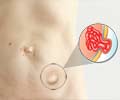Incisional Hernias - Causes
Patient-related factors
Patient factors are diseases or illnesses that impair wound healing. The three principle examples are infection, malnutrition and diabetes.
- An infection of the surgical incision impairs wound healing. In part, this may be because sutures and tissues are destroyed by the infection.
- Malnutrition leads to poor wound healing because the nutrients necessary for good healing are present in insufficient quantities or are completely absent. Malnutrition may be a generalized condition in which proteins and energy are deficient, or a specific condition, such as lack of a specific vitamin. Scurvy, which results from vitamin C deficiency, is an example of a deficiency in one key nutrient that leads to poor wound healing.
- Diabetes Mellitus also impairs wound healing and is associated with a higher incidence of hernia formation than the general population. Diabetes affects wound healing by impairing the function of white cells, predisposing the patient to infection and limiting the ability of new blood vessels to grow into the healing area.
- Chronic illness of any type also affects wound healing through problems with nutrition and a general increase in inflammation.
Technical factors
The principle technical factor that leads to an Incisional hernia is too much tension on the incision when it is closed. This can lead to:
- Tearing- Tension sutures can tear through the tissue when added stress is placed on it, such as during coughing or lifting.
- Decreased blood supply- Excessive tissue tension can also reduce blood flow to the tissue around the suture itself. This leads to breakdown of the tissue and the suture pulls through.
Other technical factors unrelated to tissue tension may also play a role. For example the sutures may have been placed in weak tissue, the wrong layer of tissue may have been sutured, the suture may have broken or the suture may not have been strong enough for the tension it is later subjected to.














